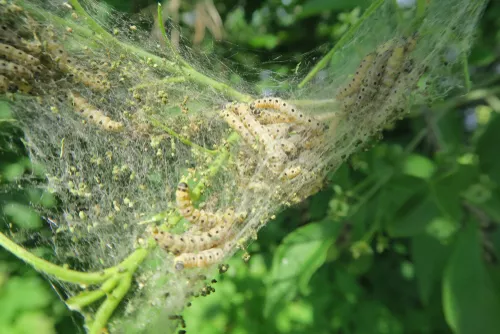The euonymus is considered a robust wood that is hardly affected by diseases or pests. When conditions are less than optimal, infestations by three pests can occasionally occur:
 The spider moth is a common but relatively harmless pest
The spider moth is a common but relatively harmless pest
- Spindle Tree Moth
- felt gall mite
- Spindle Tree Lid Scale
Spindle Tree Moth
This moth uses the spindle bush as a host plant for laying eggs. The larvae develop fine webs, some of which extend over the entire bush. They feed on the leaf mass and can completely bare the shrub. Since the larvae pupate by the time the leaves sprout twice, the spindle shrub quickly recovers from an infestation.
felt gall mite
This pest settles on the underside of the leaf to suck the cell sap out of the veins. An infestation can be recognized by whitish, felt-like hairs that can extend from the central vein over the entire underside of the leaf. The top often appears yellowed, but in most cases remains unchanged.
The mites live sociable in the felty hair structure. They are 0.1 to 0.2 millimeters in size and can only be seen under a microscope. Hibernation takes place in the buds of the spindle tree or in cracks on the bark. A heavy infestation can lead to leaf fall. Normally, felt gall mites do not cause any major damage and do not need to be fought.
Spindle Tree Lid Scale
Since the 1990s, this pest has been appearing more and more on the spindle tree, sometimes causing major damage. The Japanese spindle (Euonymus japonicus) is particularly affected. The scale insect spreads in dry and warm conditions. Container plants are attacked more frequently than outdoor shrubs. The first signs of an infestation are light colored spots on the upper side of the leaf. Under favorable conditions, the pests spread rapidly throughout the bush.
The females are fertilized in autumn and overwinter on the bush. In the spring, they lay up to 50 eggs under their shield, from which orange-yellow larvae hatch in June. These are mobile and spread out on the leaves to suck out the cell sap. If the infestation is severe, the plant can be weakened, resulting in premature leaf drop.
You can do this:
- Cut off and discard plant parts
- Scrape shields from leaves and shoots
- encourage natural predators such as ladybugs and lacewings